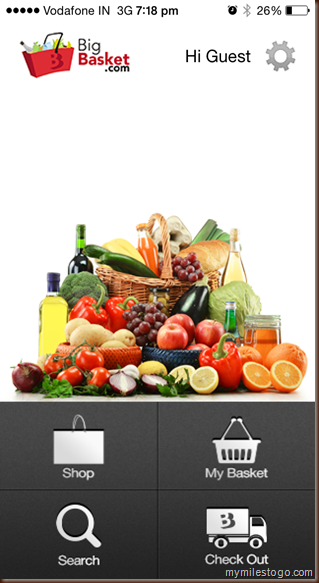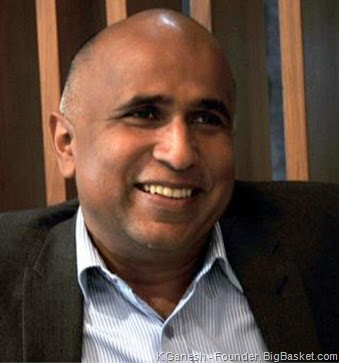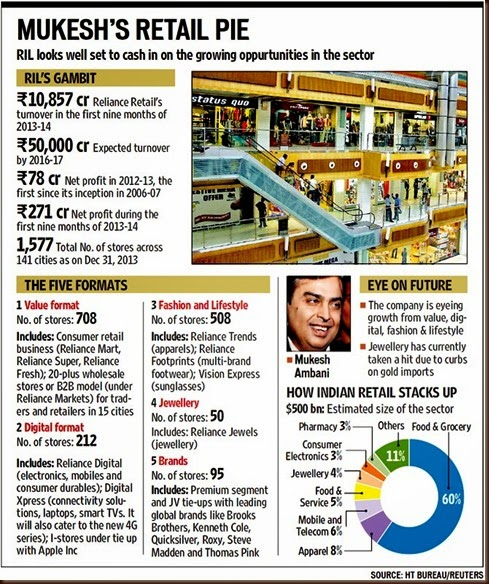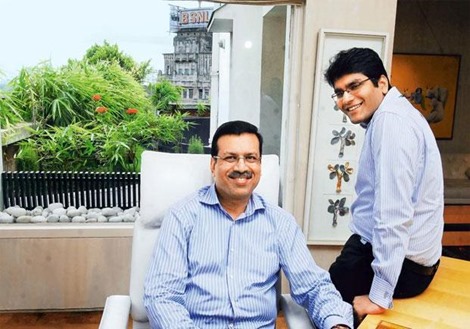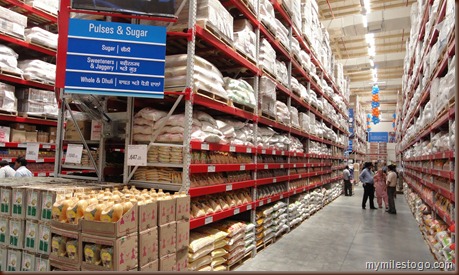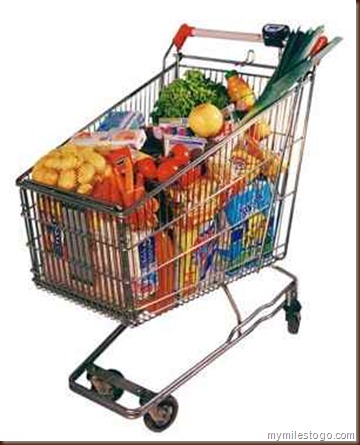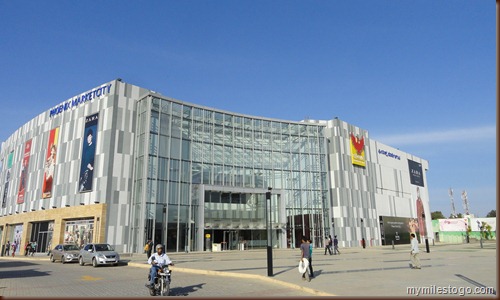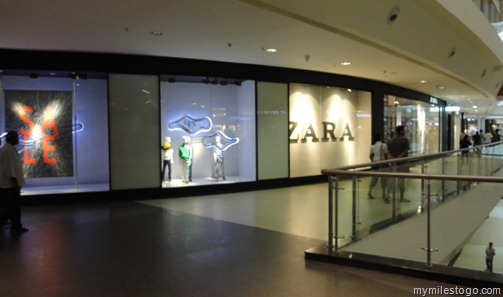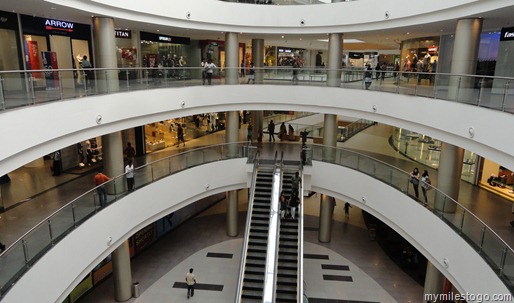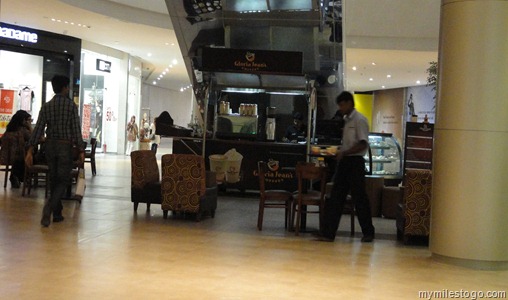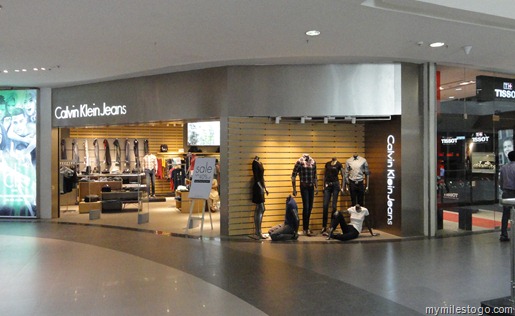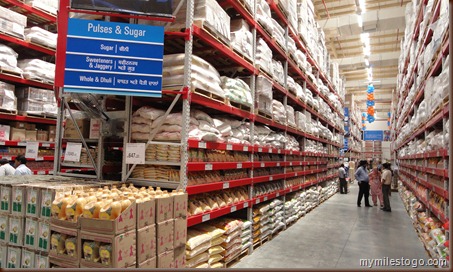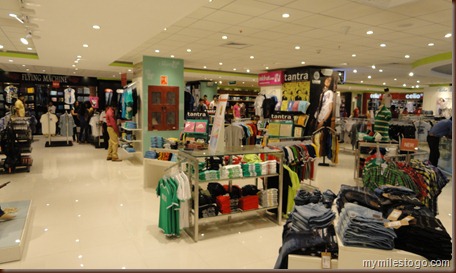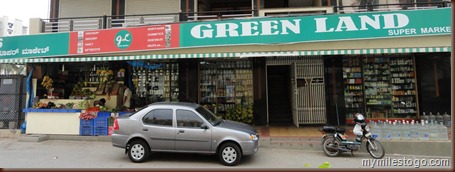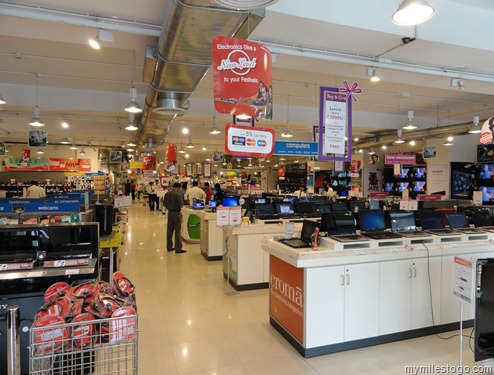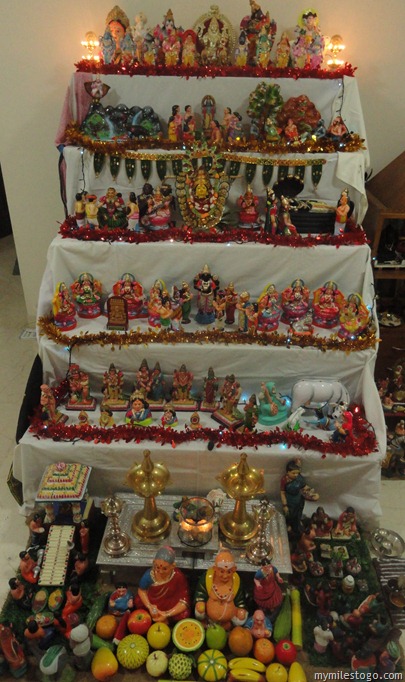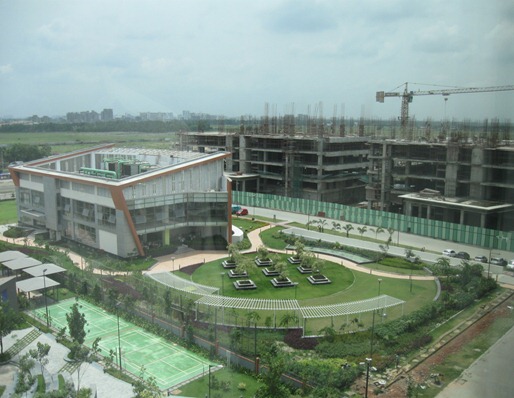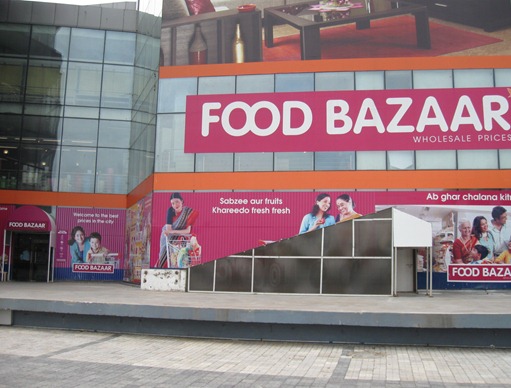16 January, 2015
Breaking fast the traditional way!
12 June, 2014
Online Grocery Shopping
There has been enough spoken and written about the Flipkart-Myntra deal. Online Commerce is no more a hype at the moment and there is no money to be made – that’s the response most subject matter experts are saying although they don’t want to be quoted since they are in various advisory capacities for many such companies. With a healthy two-digit margin, if offline Retailers are not able to succeed (read: profitable), then how would these companies survive- they ask. Having said that, there is not a single ECommerce company (in India) that has tasted profits yet. While many promoters have made millions of dollars collectively, the companies in question still remain unprofitable. I would presume that a very few of them would even be making unit level margins. Such is the discount structure and focus on Topline that these companies are almost forgetting that the main intention of a business is to create value through profitability and not just a valuation (to subsequent investors). Amongst the online frenzy across categories, the most dreaded and the most challenging category is grocery & daily needs including fruits and vegetables. Bangalore based BigBasket.com already has some headway while WeStaple.com from Noida and a few others who are regional players are taking the lead to establish their positions. Big Basket even has a Mobile app for Android and iOS from Apple. Take a look below at what their customers have to say;
https://www.facebook.com/Bigbasketcom
http://venkysundaram.wordpress.com/2013/05/29/why-i-stopped-using-bigbasket-com/
https://www.facebook.com/WEstaple
K Ganesh and his wife Meena Ganesh are an entrepreneur and angel investor-duo. BigBasket, which is run on a daily basis by the founders of e-tailer Fabmart, on the other hand, is one of India’s only online grocery stores. Online grocery stores have been seeing big traction around the world, as recurring orders prop up the profitability of the niche e-commerce category. “The Series B funding for BigBasket, which should close in the next three-to-four months, will be around $40- $50 million. We believe it has huge potential, with gross margins of nearly 20 per cent. Every order is profitable for us on BigBasket,” Mr. Ganesh told The Hindu.
Bigbasket founder Hari Menon, a successful entrepreneur who sold his brick-and-mortar retail chain Fabmall and Trinetra to Aditya Birla Group, is bullish. “It’s a huge, underserved market. Convenience is a major factor in our metros. We are finding that at least 85% of our customers return after the second order.” Menon said that revenue is increasing 20% each month. Bigbasket delivers 4,000 orders daily. In Mumbai, where the average size of an order is Rs1800, it does 800 deliveries each day. The site has served 200,000 customers so far and is expanding to Delhi and its suburbs. Menon said the company did Rs85 crore ($14.3 million) in revenue in 2013-14 and was on course to do Rs200 crore ($33.7 million) in sales this fiscal year.
While the category is exciting, most customers seem to expect the savings (on real estate) to be passed on to them, which in reality is not. If the Real Estate savings are about 10-12% on Sales, the promotions and marketing costs are much larger than that, especially the first-time acquisition cost of customers. While most players do not offer much of discounts for every item, there are chances of combined savings when you buy more quantities or multiple brands from the same company.
However, the overall sentiment seems to be simple- customers would buy products online only if they value their time more than the time spent in shopping offline at Retail Stores such as Spencers, Foodworld, Nilgiris, Big Bazaar, etc. India has a huge density of Kirana Stores while Organized Retailers in the big cities are already quite popular for more than a decade now. Fruits and Vegetables are still preferred to be bought from the vendors who sell fresh quality items, most of them directly sourced from the Markets. Retail FDI in multi-brand retailing is a contentious issue and even the new Modi-led Government is not actively pursuing this at the moment, for the benefit of the trader community who form a big chunk of vote bank.
Online Grocery, at the moment is restricted only to those who work in odd-times, say BPO Employees and many others who would find it difficult to shop at a nearby store especially those who live in far off suburbs. Having said that, the Kiranas are much more active these days, offering various facilities such as door delivery to credit facilities to their customers. While Online Grocery has a great future, time will be a real reckoner.
25 April, 2014
Happy Hours on the Web
The term “Happy Hours’ is better known for a “Buy One. Get One Drink Free” at most bars and restaurants all across the world. F&B Retailers have for long used this to lure customers to trickle in to their premises during the lean times, which is typically between 3pm – 8pm and Happy Hours are usually between 5pm – 8pm. While the margins on alcoholic beverages are quite high, say 200 – 500% on Sales, Restaurateurs forego some of it to get customers and utilize the time well and also hope that these customers would continue much after the Happy Hours are over. Also, consumption of food during the course of having a peg or a mug is quite high and hence they make money on it as well. I remember, a tony Restobar on Church Street in Bangalore offerred a group of 8 of us Happy HOurs even after 8pm, knowing fully well that the business that would arise out of our total consumption is well worth it.
What is new, is that e-commerce companies are now promoting their “Happy Hours” to lure shoppers to buy online during the so called “lean hours”. What is interesting is that the business on the web is busy only during a few hours in the day. As you would guess, it is during the day time, and between lunch and evening. The reasons for this kind of hectic activity is as follows;
Broadband Speed
Most (online) shoppers’ households still do not have the kind of internet speed that’s available at their respective offices. The Airtels and BSNLs of the world do not offer seamless connectivity that the IT Managers in small and large companies work relentlessly to ensure connectivity all the time for business purposes. And therefore consumers prefer to shop online during office hours. Incidentally, IRCTC sees hectic activity between 9am – 11am, especially for tatkal bookings.
Secure Access
Home internet is certainly not as safe and secure for making online transactions, and is vulnerable for hacking, especially by fraudsters who are constantly monitoring those who are shopping online. So, online shoppers tend to believe that office internet is much safer and is hack-proof, although it is indeed a misnomer
Delivery
Many youngsters live away from their families these days, mainly owing to work and do not have a permanent address. Some others do not have anyone to collect the goods being delivered, especially if they as COD – Cash on Delivery products. Hence it makes sense to get them delivered at their office making it more convenient.
Boredom
Over the past decade, the internet has been an important leveler to kill boredom. During the initial days, it was just about reading (Internet 1.0) where one could only transact one way. Then came the years when Google started invading our lives with various products, Youtube being a very important one. Social networking has seen hectic parleys over the years including Facebook, Twitter, Pinterest and so on. Online Shopping is a mere extension. People shop online, from grocery to gadgets, tickets to gifts, just to kill their boredom. Also, long office hours (during the week) and travel to hometown (over weekends) doesn’t allow many to shop at High Streets and Malls.
Desktop / Laptop
While mCommerce or shopping on the Apple or Android smartphones is becoming common, shoppers still prefer to see the products on a wider screen such as Desktops and Laptops as it gives them a better view of the products. Also, the reliability of 2G/3G connections is much lower than on wifi/broadband services.
I read this recently on the web;
“If I want to find something, I will Google it. If I want to buy something, I will Amazon it.”
Very powerful statement.
Amazon India recently launched a campaign to encourage shoppers to shop online during the evening hours, promising them best deals in town. I guess more and more etailers would follow this trend shortly. "Working hour visits are the highest—there's a spike around lunch time and evening and dies out at night," said Sandeep Komaravelly, vicepresident, marketing, Snapdeal.com told in a recent interview to The Economic Times. "Besides, weekdays are busy for shopping online, while weekend traffic drops by 10-12 per cent, particularly on long weekends like this one." Hasbro Clothing, the parent company of basicslife.com runs 100 exclusive offline stores and also retails via 800 multibrand outlets. "Office net connectivity is much faster than at home, prompting quick purchases at work," said Sriram Ravi, head, digital marketing, Hasbro Clothing. "We get 20 per cent daily orders around lunch time and marked increase during office closing hours. People are done with the day's work and use the last hour to browse and buy from shopping sites, while on weekends, sales in retail outlets are higher." Average time spent in buying boxers or handbags or shoes online is five to 10 minutes and these are typically repeat buyers, familiar with a site and knowing what they want.Same-day delivery options are also pushing buyers to shop during office hours. For example, eBay India offers nine-hour delivery, but for this, orders have to be placed by noon. At Amazon, orders have to be placed by 10 am to qualify for sameday delivery according to The Economic Times.
Honestly, there is no good time to shop. Anytime is a good time, from the view point of Retailers. It’s just a matter of time that Offline Retailers would also start offerring discounts during lean hours, a practice started by United Colours of Benneton many years ago. For now, check out the web for special deals. If you reading this later in the evening, you may be in for a surprise! Happy Shopping…
21 March, 2014
Reliance wins handsdown
The first store for Reliance came up in Hyderabad. It was a grocery retail format and many skeptics wrote off the idea, citing intense competition in this segment. Gross Margins are low, two-digits and net margins, if any are a mere 4-6%. So, how would the company ever make money? Further, there were already established players in this segment, especially in the South (of India) such as Foodworld, Spencers, Food Bazaar, Nilgiris, FabMall, Trinetra (now together More), Fresh @ from Heritage Foods – the list could go on! But patience and perseverance has helped the company in the long term. According to a report in the most respected Hindustan Times newspaper, the company would become the largest Retailer in India by Sales in 2013-2014. The company is expected to close the year with $2 Billion in Sales, approx. INR 12,000 Crores. And it made a meagre INR 78 Crores last year and has made INR 278 Crores in 2013-14. That’s not bad at all. The company has been able to achieve scale over the past 7 years and its many Chief Executives of respective businesses have built the business brick by brick, sweating and toiling between Board Rooms and Store fronts.
Take a quick look at how the numbers stack up;
It’s a commendable achievement for Reliance Retail to achieve this position. Those who know me well would now agree what I have been saying ever since Reliance joined the fray in the Retail sector. I predicted right in the beginning that they are here for the long term. With a cash pile of INR 90,000 Crores and managing the largest Oil refinery in the world, Reliance has real deep pockets. And its Chairman Mukesh Ambani is not someone to open and shut businesses. Its not in their blood. Dirubhai Ambani, the patron founder of the group tht every household in India should have a Reliance product in some form or the other. The group created a furore in 2002 when the Reliance Mobile network was launched with an exciting Rs. 501/- package making it the most affordable mobile phone of its times. Similarly, they forayed into various other businesses and turned around all of them, albeit patiently.
One of the biggest reasons why Reliance has been able to reach where they are is also because of steadfast focus in the formats that they have opened and operated. They just have one Hypermarket, One Digital Electronics Format, three formats in Fashion, one in Jewelry and half a dozen international brand tie-ups. Makes it easy to focus on scaling up each vertical constantly. Reliance operates small supermarkets which compete with Kiran Stores and other organized players such as Spencers, Foodworld, Food Bazaar, etc. Reliance hyper directly competes with Metro AG, Best Price (Bharti Retail), Hypercity (K Raheja Group), Total (Jubilant Retail), Big Bazaar (Future Group) nd other local wholesale markets and APMC operated mandis. In the fashion segment, Reliance Trends is positioned against Lifestyle (Dubai based Landmark Group), Shoppers Stop (India’s largest Department store Chain) and Pantaloon (now owned by Aditya Birla Group). Reliance Footprints has a unique positioning and doesn’t have major names for competition except Metro and Mochi who have a pan-India presence. Reliance Jewels competes with the local jewelry stores in each micro market. Reliance Brands such as Diesel, Quicksilver, etc. compete with their international competitive brands.
This is just the beginning. Look how Reliance is going to grow leaps and bounds in times to come. I am still sure that they wouldn’t have a JV with the global biggies such as Wal-Mart, Carrefour, etc. They would rather grow organically in times to come.
The game gets more interesting.
13 May, 2013
Shaswat Goenka–Hearlding new frontiers at Spencers Retail
After dabbling with various sectors in the Rs 14,000-crore RP-Sanjiv Goenka group for about a year, Shashwat Goenka, 23, son of group chairman Sanjiv Goenka, has taken charge of Spencer's, the retail chain, from April 1. In an interview with Namrata Acharya & Ishita Ayan Dutt of Business Standard, he talks about his personal mandate and the road map for the Rs 1,400 crore business. Edited excerpts:
What goal have you set for Spencer's?
I assumed the role of sector head from April 1. What is most important at this point in time is profitability; that's where we are all trying to go. That will be the focus for the coming year and the year after. Spencer's is aiming to deliver Ebitda (operating earnings) breakeven at a company level in the third quarter of 2013-14 and be Ebitda-positive on a full year basis in 2014-15. That's the overarching short-term goal.
Spencer's has missed its breakeven deadline quite a few times. What makes you think you would be able to achieve it?
Well, each time we have done better. We have achieved breakeven at store-level but company level is what we want to achieve.
How do you plan to get there?
We want to increase our footprint. We will go up to two million sq ft from 900,000 sq ft currently and will expand in the north, east and south over the next four to five years.
We will achieve it over the next few years. The other important thing, obviously, would be operational efficiency.
In terms of offering, we would look at increasing international foods and regional foods. Value-added fresh is one of the areas we would like to explore.
Doesn't the fresh segment have one of the lowest margins?
We have very good margins in the food business compared to our competitors. Margins in apparel are obviously much higher but our margins in foods are good.
Any new formats for Spencer's on the anvil?
We haven't thought of any. We want to grow in hypermarkets.
Is the rationalisation process for Spencer's over?
Last year was the rationalising and consolidation process. We have exited Pune. In the past two years, we have closed 65 stores. Now, we want to start growing and in the hypermarkets.
Earlier, we had hyper, super, daily and express stores. Now, we have hyper and dailies and a few of the old express stores are still functioning.
Why did you exit Pune?
We wanted to become stronger where we are. So, we wanted to focus on the north, south and east. After we get that strong, we will revisit the west.
Why do you think the response from foreign retailers has been muted, after FDI (foreign direct investment) has been cleared?
I think people are interested. They just want to figure it all out before they come in.
Do you see foreign retailers as a threat to Spencer's?
Walmart and its likes coming in will help us. We can learn a lot from them. Back-end infrastructure will improve. There are basic infrastructure issues in India, like roads. Also, cold chains or dairy chains, for instance, are not very well developed.
A lot of options were being explored at the back-end by retailers. Any progress on that front?
We are open to FDI at the back-end but we haven't been approached by anyone.
Spencer's was exploring the IPO (public share offer) option. When is it likely?
That's something we definitely want to do but right now, the focus is on profitability.
Would you look at getting into the cash and carry format?
We have not looked at it. We want to be profitable and then explore other things.
18 September, 2012
The Retail FDI brouhaha!
Popular Media is in full force discussing the pros and cons of opening up FDI in multi-brand Retail, announced by the Manmohan Singh led Union Government of India on 14 Sep. 2012. Finally, it happened. Rather, it had to. On 9 Jan 2012, the same Government allowed 100% FDI in Single Brand Retail, acting as a precursor and paving the way for the current policy decision. The UPA Alliance which leads a multi-party coalition Government has finally had the spine to push this through, alienating some of its own partners putting its Government in jeopardy. With the current policy in place, it means that multi-national Retailers such as Wal-Mart, Carrefour, Tesco and their likes can invest in India on their own as well as in Joint Ventures with Indian partners or Business Houses. But, there is a catch. FDI in Retail has been made a State Subject which means that each State has to provide an approval for each partnership that is proposed and to be allowed to be operated within its precincts. This is a bit absurd, to say the least. The policy states that over 30% of input must be locally sourced, which in my opinion is a very good thing for Indian traders and businessmen.
(Suggested Reading: Starbucks in India)
So, lets see what’s in store for consumers with multi-brand FDI in Retail;
Pricing
By allowing FDI in Multi-brand Retail, the end consumer is expected to get better pricing for most products. In case of Agri-products, even the Farmers are expected to command a better pricing since they would be dealing directly with the Retailers. Since these Retailers purchase large quantities of products from FMCG companies directly, they would be able to get better margins and would thereby pass them on to Consumers. This is largely in case of Grocery Retailing. It would be similar in Electronics Retail too. Fashion Retailers who run a chain of stores would be able to procure their merchandise at better rates from manufacturers and would again pass on the benefits to their customers. This is one important area where everyone gains!
Assortment
At the moment, products manufactured / produced in one part of the country are not available in many other places. This is mainly because of Supply Chain Constraints. Multinational Retailers don’t just bring big bucks, but also the knowledge and know-how of how to do things better. This, would be an important part of the proposed Retail expansion of Organized Retail, with traders getting more scope for their products. Customers will get a wider variety and range than before which will throw open new options and opportunities for consumption.
Generate Employment
Retail trade as a whole employs about 8% of the population in the country, directly and indirectly. These people are paid a fixed amount as compensation and do not benefit with other Government schemes such as Pension Fund, Provident fund, Employee State Insurance, Gratuity, etc. Modern Retail already provides most of these benefits to its staff. With more and more Organized Retail Stores opening up, it is expected to generate higher employment across the country.
(Suggested Reading: Retail Staffing)
Credit availability
One of the popular qualms is that the neighborhood Kirana provides free credit which the Organized players may not be able to and would hence lose out on. This is incorrect. Spending through credit/debit cards has grown over 6 times in the past decade within Modern Retail. Customers are happy to swipe their cards even for smaller transactions, more for ease than anything. Retailers like Shoppers Stop and Big Bazaar have co-branded cards, thus exciting customers with higher reward points for purchases.
Recreational Spaces
Modern Retail is not just about shopping in a comfortable environment but also includes a lot of fun and entertainment for families. These large stores have F&B facilities, gaming zones, etc. where children can unwind while parents are shopping. It is also an excuse for families to go window-shopping and end up buying something or the other!
And here is why a few segments of the people are against it;
Kiranas would shut-shop
The oft-heard uproar is that Kiranas would shut-shop due to the emergence of big-box multi-national Retailers. This is untrue. Kiranas have their basics right, starting with Location, Pricing, Assortment, Credit to Customers, to name a few. Large Retailers take time to crack even some of these points. Having present in India for over a decade, Domestic Retailers such as Foodworld, Spencers, Reliance Fresh, More, etc. haven’t got their act correct, I would say. If they have a good location, then their pricing is (obviously) not so competitive and even if they attempt to, then they are in the Red. Merchandising is one of the most difficult paradigms of the Retail business coupled with severe Supply Chain constraints in the Indian scenario. Given these, it would be almost impossible for large Retailers to succeed, whether they are of Indian origin or International.
(Suggested Reading: Store Opening )
Secondly, most of the Kirana stores (Mom-and-Pop-Stores) are first generation entrepreneurs in their 40s and 50s who started off their own little corner stores during the 80s and 90s after Liberalization. Some of them include women, who run petty shops in neighborhoods to support their family, sometimes as a main source of income and at times as alternate, additional income. Their children, most of whom are undergoing good education are moving out of the family businesses. Many youngsters aspire to become Diploma holders, Engineers, MBAs, etc. across a wide range of subjects and are hence not looking forward to continue the family’s traditional Kirana business. As it is, many shop owners are not looking at continuing their petty businesses for the coming generations. So I wonder why this hue and cry.
Many Kiranas have already embraced modern Retail. For example, Metro AG which set shop ten years ago in Bangalore now has half a dozen stores spread across the country. Most of its customers are traders and merchants who buy from Metro and sell to end-users (customers). Wal-Mart set up a JV with the Bharti Group a few years back and runs Cash & Carry Stores in Punjab, Haryana and Rajasthan. Its main focus is on Kiranas and Retailers to whom they sell stuff in tonnes! Even in big cities like Mumbai and Chennai, it is quite common to see Retailers shop at the likes of Reliance Mart and Big Bazaar, given the substantial savings.
Kiranas are a tough lot and represent the well-entrenched Indian Entrepreneurship and cannot be unseated so easily. Long Live Kiranas!
(Suggested Reading: David Vs. Goliath)
19 February, 2012
Phoenix Market City–Everything for Everyone!
Yet another mall opened its doors recently in Bangalore – this time in the far eastern limits of Bangalore, near Whitefield. After a successful launch at Pune and Mumbai, the Mumbai-based Phoenix Mall Management has launched their prestigious project in Bangalore. This is the largest mall in town with an estimated 1.80 million square feet of space – a multi-development concept and one of its kind in the city that also includes a half a million square feet of office space, a 5 Star hotel with 236 rooms, a service apartment with 174 rooms and a multiplex spread over 55,000 sq ft. The external beauty lies in the fact that it is horizontally spread than vertically – all of four floors and a lower ground which connects directly to the most spacious parking lot which is well spread and brightly lit. The construction architecture is minimalistic with no jazz – focus is on the Retail Stores than crazy designs and confusing walkways. This mall also launched for the first time in Bangalore, marquee brands such as Zara, the Spanish fast-fashion retail chain in a JV with the Tatas (Also Read: Starbucks India – a TATA Alliance), Calvin Klein, Gant and California Pizza Kitchen. The main anchors include Big Bazaar, India’s largest Grocery and Homewear Hypermarket chain, MAX Hypermarkets, Reliance Trends, Reliance Digital and Reliance Time-Out. Regular Mall names such as Benetton, Tommy, Fab-India, Titan, Louis Philippe, Arrow are present while a few such as Café Coffee Day, Barista are conspicuously missing!
The best thing about the mall is that it has everything – for the first time, multiple entrances – from the main entry gate, from the sides (Drop-off area), and from the basement parking area. The Ground Floor (entry level) is rather wide and broad – spacious enough to make it appear like a premium mall. Tommy, Gant and Zara welcome visitors with their bright signages and show-windows. Once inside, the shopper gets to see the wide expanse through well thought out and planned cut-off areas – from one floor, there is ample visibility to other floors.
The anchors are also well spread. Big Bazaar is closer to the Parking Area so it would be easier for customers to take their shopping trolleys to their vehicles; however one needs to walk almost half a mile to the main road if they don’t have a personal transportation – an area that must have been given thought to. Max Hypermarkets welcome you once the shopper enters from the lower basement. Pantaloon Fashion store is placed in the upper floor while Reliance Digital (the Electronics Store) is in the lower basement too. There is a small gifts shop – all of 400 sq ft which is packed with curious onlookers for all the fancy cheap Chinese imports that the store has. The Foodcourt is as always, on the top floor nearer to the Cinema Halls while the Gloria Jeans coffee shop is sadly placed beneath an escalator with sparsely spread out seats – some wooden and some sofa seating in some random manner! Obviously, the café doesn’t commensurate its great coffee with its ambience. The other coffee shop, Costa is placed on the top floor – some logic I guess!
I walked for over an hour, before understanding the layouts and placements, familiarizing myself – I scored lesser marks in my own purview although I wonder if shoppers would get to know it even after as many as 3-4 visits. Zoning, which I know personally had taken many months with inputs from some fabulous international consultants is to say the least, sad. Maintenance costs would be sky high I guess – air-conditioning such a wide area with two dozen security guards for over 14 hours a day is not going to be cheap or easy. The escalators – onward and downward are placed next to each other thereby not diverting traffic in various directions. Signages- although we don’t read as much – are scarce.
Overall, this Mall has tried to become everything to everyone – a premium mall in one-fourth of its space and a normal neigbourhood shopping centre with the rest. While Big Bazaar and Max are expected to draw a different set of clientele than, say a Zara or Gant, they are placed far behind – from a real estate point of view, this probably makes sense. But just that. Most people who intend to shop at a Hypermarket would be passing through premium retail stores – not only would they find it out of place but also a bit weird. Also, the Hypermarkets, whose predominant customer base are those who depend on autos and two-wheelers would find it taxing to come and shop here. And btw, Big Bazaar has its store close by – within a 3 km distance to be precise. Other than being a show piece, I wonder if they have any other reason to be here. And for the customers of premium Branded Retail stores – the car parking areas are just too far away. Wonder if that would put them off. Except if they have specifically come to shop at, say the iconic Calvin Klein.
Firstly, does Bangalore need such a large Mall? With congested roads and consistently heavy traffic not just at the CBD but almost everywhere in the city, what we need are a number of neighbourhood malls – within a 4-5 sq km radius and within a 15-20 minute drive. And this everything under one roof doesn’t work as much. Bangalore, or most Indian cities do not attract a huge tourist population such as Dubai or Singapore. Nor are our prices globally competitive, rather more expensive. The semi-urban crowd that comes to the larger metros and cities rather stick to traditional shopping areas (Read: Downtown shopping centres, predominantly the semi-organized retail stores). The Mall also needs to attract 3-4 times what the best Mall in town attracts today – to support the single-digit conversions at its stores. For a Mall that is located so far off, it is anybody’s guess if the Mall or its tenants would do well in the first few years. Maybe over 3-4 years, the location would attract some traction.
Needless to say, the group has invested significantly and so have the Retailers. Here’s wishing them good luck in times to come.
01 January, 2012
Retail in India–Way ahead for 2012
Organized Retail in India has come a long way over the past decade and 2011 was expected to change the wind towards the positive side, due to allowing FDI in Retail. Thanks to political unrest and the opposition parties claiming hoarse, FDI in Multi-Brand Retail has been put on hold (hope not shelved) while FDI in Single Brand Retail has quietly been allowed, atleast on paper. While a few International Brands such as Benetton, Tommy, Diesel, Esprit, etc. have been operating in India for many years now through Joint Ventures with Indian partners, a beeline of Brands wanting to enter India is expected in 2012 – a hope that many in Retail have been holding on for sometime now! The coming months are expected to be exciting times for our Industry and here’s a view on how this landscape would evolve;
Malls
From a lakh square feet to a million square feet in 10 years, modern shopping centers aka Malls have walked a long journey all these years. Today, Malls are not places for consumers to just shop but a generous mix of shopatainment – which includes Shopping, Dining and Entertainment. While there are over 200 operational malls today in the country, another equal number is expected to come up in the next few years. A number of mall projects which commenced during the slowdown in 2008 are ready for occupancy now and many are expected to launch this year.
Supermarkets
The neighborhood supermarkets have evolved the most, among all formats of Retail over the years. Size was always a concern for players like Spencer’s and More – getting it right was a challenge, either the stores being too big with empty shelves or too small with regular stock-outs. Many players have exited the marketplace while a few like Food Bazaar and Nilgiris (through franchises) are increasing their presence assuming scale-up would help them gain overall net margins which range in high single digits. This would be the first format, in my opinion that would straighten up – only serious players would exist and they would do a great job while many others would exit – hopefully this year.
Hypermarkets
With foreigner CEOs and advisors engaging the managements of Indian Retailers, it was widely believed that Hypermarkets must be large, really large like the ones in western countries.Thanks to some early learning, many players like Hypercity and Total have corrected their ways of working. Small is the new Big, with Hypers ranging from 20,000 – 45,000 in prime retail areas in multi-level locations compared to the earlier proposition of being over 60,000 sft – one single floor in suburban areas! Newer players especially multi-nationals like Tesco and Target are expected in this format in the coming year while existing players are planning massive scale-ups.
Department Stores
These large format stores, the blue-eyed ones due to their colorful appearance was and is expected to be the only ones to see some EBIDTA in their early years. That’s a boon and bane in a sense in this format. To ensure they attract high-spender footfalls regularly, they should turn their stocks quite often; that means having the right mix of merchandise is extremely important which is a direct impact of having high quality staff who can choose the right merchandise every consecutive season. This is a vicious cycle and players like Shoppers Stop, Lifestyle, Westside etc. have got it right while a few of them are still struggling to learn.
Specialty Retailers
Stand-alone specialty stores of international and even domestic brands are seeing dwindling numbers. The total number of stores that were being added year-on-year have reduced considerably. If it was 20 new stores and most being unprofitable four years ago, the numbers have reversed, thankfully. Most brands don’t talk about crazy numbers anymore, only well-merchandised stores and outlet level profitably.
QSRs and Food Retailing
It seems cooking and eating at home is a more expensive proposition these days thanks to high food inflation and going by the sales of pizza chains and fine-dine restaurants. While Dunkin Donuts is almost ready with its first outlet, Starbucks is slated to open quite soon too. Café Coffee Day will ad over 200 new cafes this year while Dominos and Pizza Hut will have company in California Pizza Kitchen and a few others. This would indeed be the most exciting format to watch indeed!
Kiranas
The unorganized retailer down the road doesn’t pay taxes or offer health benefits to employees; no one ever checks the quality or quantity of goods sold; BUT he is able to offer lower prices everyday to consumers with other additional benefits such as short-term credit and quick home delivery. Modernisation is the byword for the them and they are indeed giving a touch competition to the organized players.
E-Commerce
But the real competition, if not threat to all formats of retail in 2012 is going to be through E-Commerce. Sadly, many brands and retailers are not paying attention to the increasing internet user base – over 100 million as of 2011 compared to just three million in 2001. This has allowed fly-by-night operators to open websites that sell everything from toothpaste to watches, apparel to expensive jewelry! Most of them have no clue how e-commerce works and many are even buying merchandise and selling – something which goes against the fundamental philosophy of transacting online!
29 November, 2011
Retail FDI - Letter from the Commerce Minister of India
Last week, the Cabinet of the Indian Government allowed 100% FDI in Single Brand Retail and upto 51% FDI in Multi-Brand Retail - it was indeed a surprise move, given that the Winter session of the Parliament is on and the Ruling UPA is mired under various issues due to which the Upper House and the Lower House have seen continued agitation and adjournments. In the wake of this latest crisis, Union Minister (of India) for Commerce, Mr. Anand Sharma has written a letter to the leaders of all the leading political parties in India, explaining the reasoning behind the government's decision to allow FDI.
Here is the full text of the letter;
As you are aware, the Union Cabinet has taken a decision for liberalization of the Foreign Direct Investment (FDI) policy in Multi-Brand Retail, which holds the potential of transforming rural economy and unlocking the supply chain efficiencies in the agri-business.
The policy has evolved after a process of intense stakeholder consultation which commenced on 6 July 2010, when a discussion paper was floated by our Ministry. Comments from a wide cross section of stakeholders including farmers associations, industry bodies, consumer forums, academics, traders associations, international investors were analysed in depth before the matter was deliberated by the Committee of Secretaries on July 22, 2011.
The matter was finally discussed by the Cabinet on 25th November and a view was taken to allow liberalization in multi brand retail. In doing so, we have consciously adopted a model with a distinct Indian imprint, recognizing the complexity of Indian society and the competing demands of different stakeholders. Over the years, while we may have transformed into a service led economy, yet even today India primarily resides in the villages and an overwhelming majority of people are dependant of agriculture. It is a tribute to our farmers that India is the second largest producer of fruits and vegetables in the world with an annual production of over 200 million tonnes. Yet, in absence of adequate cold chain infrastructure, logistics and transportation, our post-harvest losses remain unacceptably high. A large part of farmers produce perishes and never reaches the market. A complex chain of middlemen have a cascading impact on supply inefficiencies and prices as well. As a result, on the one hand farmers are unable to secure remunerative price for their produce, while consumer ends up paying more than 5 times the price secured by the farmers.
Opening up FDI in multi-brand retail will bring in much needed investments, technologies and efficiencies to unlock the true potential of the agricultural value chain.
The policy mandates minimum investment of $100 million with at least half going towards back end infrastructure including cold chains, refrigerated transportation, and logistics. We have also stipulated mandatory 30% sourcing from small industry, which will encourage local value addition and manufacturing. It will also unfold immense employment opportunities for rural youth and make them stakeholders in the entire agri-business chain from farm to fork.
I felt it my duty to dispel some apprehensions expressed by certain political parties. In formulating this policy we were conscious of the livelihood concerns of millions of small retailers.
Informed studies of global experience has revealed that even in developing economies like China, Brazil, Argentina, Singapore, Indonesia and Thailand, where FDI is permitted upto 100%, local retailers have found innovative ways to co-exist along with organized retail and are integral to the organized retail chain. In Indonesia, even after several years of emergence of supermarkets, 90% of the fresh food and 70% of all food continues to be controlled by traditional retailers.
In any case organized retail through Indian corporate entities is permissible in India and the experience of the last one decade has borne the small retailers have flourished in harmony with the large retail outlets. Even then, we have therefore taken a view that in India we may permit FDI upto 51% equity and roll out the policy only in 53 cities with a population of more than a million. In the rest of the country the existing policy will continue, which will ensure that the small retailers are able to access high quality produce at better price from the wholesale cash and carry point.
We were also mindful of the imperative of ensuring food security for the poorest of the poor and have therefore retained the first right of procurement of food grains to rest with government for the public distribution system.
Concerns have been expressed that the multinational companies will resort to predatory pricing techniques to drive away small retail. You are aware that the Competition Commission has been established by law to ensure that such practices receive great scrutiny and I have specially discussed the matter with the Chairman of Competition Commission to build in regulatory capacities to ensure necessary checks and balances. In any case, you will appreciate that predatory pricing works in markets with high entry barriers, which is not the case in India.
The Indian consumer will undoubtedly gain significantly from this step as they will be afforded much greater choice, better quality and lower prices. In the medium term, even RBI governor feels that this step will have a salutary impact on inflation.
I have had occasion to discuss the matter with a wide cross section of all stakeholders, including farmer association, traders, consumer organizations, industry leaders, economists and there is an overwhelming case for introducing this policy. I am sure that being a political leader of long standing and experience, the benefits of this policy for the Indian citizens will find resonance with you. Policy initiatives taken in larger national interest demand political leadership to rise above partisan politics to create a healthy bipartisan consensus. This has been the strength of Indian democratic traditions.
I look forward to your personal support and understanding in the roll out of this policy for the larger public good.
………………………………………………………………………………
It is anybody’s guess if this letter would make any difference though in the current situation. India has been witnessing a rare camaraderie cutting across political parties which have taken a united stance against the Government urging it to roll back the decision to allow FDI in Retail, which looks unlikely though. In the given scenario, atleast 25 cities out of the 53 which qualify for the criteria that has been set (above 1 million population) are covered under those states that have not welcomed FDI. India INC however has voiced its opinions, most of which is pro-FDI to say the least. For the next few days, if not a few weeks the entire world (read: Business houses) would be watching how things turn out here.
Watch this space for more!
21 November, 2011
What Retailers can learn from Kingfisher Airlines
The past few weeks would have been one of the most tumultuous for India’s five star Airline, Kingfisher! The Airline and its promoter Dr. Vijay Mallya were in the news (and continue to be) for all the wrong reasons. The India Media which I personally respect a lot were making some scathing remarks and reports all of a sudden about the airline’s business health although it knew about it for many years now being a public limited company. With a debt exceeding Rs. 7,000 Crores (USD 1.80 Billion), Cash-and-carry of Fuel at airports and a few flights grounded for reconfiguration of seats, the Airline was abused by one and all including those who otherwise held it in high esteem. It was common to see many passengers at airport lounges discussing their wisdom and advising how the Airline should be run and how the promoter and the Management can do better. These were some of those who earlier yearned to be seen in the Kingfisher Lounges at airports! In fact, some subscribed for the Kingfisher-Amex credit card so they would get free and immediate access to these Lounges (obviously not for Kingfisher parties which were for the most elite). And some would go any length to get a Kingfisher calendar (in the same lines of a Pirelli calendar). Serious. No Kidding. Anybody who is somebody had a word of advice for the airline. They should do this; they shouldn’t have done that and so on. Naturally (sic).
I am not an Aviation Expert or one who shares Management Consulting for free. I have my own thoughts about the airline, and those are my views. Running a USD 2 Billion empire and being the second largest liquor company in the world (UB is expected to reach the number one position sometime in 2012), I believe Mr. Mallya and Co. knows their business best despite the unconventional ways of how entrepreneurs run their business (rare to see them plunge in Horse & Car Racing or hosting the most enviable parties at Monaco & Monte Carlo). The airline is going through some turbulence and I am sure they would come out of it sooner than later. Whether someone picks up a stake in the airline or if the Banks bail them out is one thing, but the exemplary five-star service which Kingfisher introduced is something that is worth living for. As eminent scholar Swaminathan Anklesaria Aiyar said in his recent article, “Kingfisher is worth saving!”
There are some interesting learning that our Retail Industry could take from the state of affairs of Kingfisher, which I have listed as below;
Scale-Up but at what cost
The airline was founded six years ago and has hence scaled up reasonably well, in fact started flying international since 2009 after acquiring Air Deccan (which was seen as the main reason for buying out). However, some of the routes it was operating were just not profitable. A Few were as per govt. Regulations such as flying to the North East of India, but there were some routes that could have been avoided. I guess this applies to Retailers as well. In a quest to expand their presence some Retailers like those in the F&B business such as cafes, speciality restaurants, etc. enter new cities and towns although they would just not be profitable ever! For Ex., the number of staff who are required to manage an outlet, a region & a territory would just not make sense unless the number of stores are reasonably big.
Being Everything for Everybody
At the India Retail Forum in 2010, Mr. Kishore Biyani of The Future Group made a statement which many of us in the industry vouched for – “A Retailer cannot be everything for everybody!”. Such powerful words. And makes so much sense. This applies a lot especially for Luxury Retailers. One thing that Kingfisher did was to position itself for the fashionable few with all its flamboyance and exclusivity. Later, when it bought out Air Deccan, it created a platform in the low-cost segment with “Kingfisher Red” which was recently scrapped off. In the meanwhile, Kingfisher was offering differential service patterns across its flights – some were served hot food on the house while some had to pay exorbitant prices for cold sandwiches!
Price Matters – Discounts don’t work all the time
In tune with many other airlines offering everyday low fares, Kingfisher was also pricing its fares accordingly. This, I believe was one of the earliest and biggest mistakes the airline did although it had an option not to do so. Many Retailers, to gain easy and quick market share especially Hypermarkets and Supermarkets work aggressively on their pricing and create hundreds of loss-leaders. That way, they attract footfalls in the initial stages although they would never be able to lift prices in future. This is a dangerous strategy that Retailers should keep monitoring constantly. Although it is fine to change the market positioning once in a while, one has to be careful in the long-term.

Competition – Creating a Niche for oneself
Over time, Competition will increase, irrespective of which business one is operating in. For Kingfisher, it was initially the low cost Indian counterparts and over time, International airlines were also competing for market share. This applies to Retailers such as those in the Fashion segment. It is but natural that international brands would enter India eventually, given the potential the 10 million plus affluent households we have which is their main target segment. This should be part of the Strategy and not a knee-jerk reaction.
Managing the Media
Most importantly, Media should be well-managed – always. To say the least, lesser the better. Kingfisher has been the darling of the Media, with all the red short skirts, the sexy parties and those PYTs who are partying. Every move of the airline has been well covered and captured right from the first page, the Page 3 as well as in the last pages of the newspapers (the sports pages, usually). TV Channels have never missed covering its important times, and there is even a channel dedicated to the Good Times! Most Retailers fail to engage the Media well – either they are over exposed or under-exposed. Well, its worth discussing the business priorities and problems from time to time to- and with the media, rather than bringing it all at once. The recent discussions and view points on allowing FDI in Retail is a great example. Many Retailers, who were initially reluctant on the subject have now done a volte-face because they are cash-strapped by agreeing to bring in foreign retailers in to the fray! This stance will affect them sooner than later, with the media as well as their consumers.
Life’s lessons come from various quarters all the while and this time it is in the form of Kingfisher airlines. It is up to us to make good use of wisdom, irrespective where it comes from.
03 October, 2011
Dasera – Diwali Dhamaka for Retailers
A former colleague of mine, a Swiss gentleman once quipped that everyday in India is a festival day! Well, he was right in a way, maybe not quite literally though. With so many religions and diverse cultures, indeed every day may have some form of festival in India…
This October month is one of those rare ones – that benefit Grocery Retailers, typically supermarket and hypermarket chains like Food Bazaar, Reliance, Spencer's, More, SPAR, EasyDay and others. Navaratri / Dasera, which commenced on 27th Sep continues into the first week of October and Diwali will be celebrated during the last week of the month. Typically, the monthly Grocery shopping happens once a month, usually in the last week of the month gone by or during the first week of the current month. But in this case, families would have to shop twice, and probably more quantities than usual – roughly 1.5 to 2 times the average quantities. Navaratri is celebrated in different forms and signify different things for people across the country. in Tamil Nadu, Andhra and Karnataka, families set-up dolls at home – popularly known as the “Kolu”. During this period, Goddesses Durga, Lakshmi and Saraswati are prayed and celebrated three days each. Every evening, women folk and children visit houses of neighbours and are fed with “sundal” – the nine grains, one each every day. Now – this category is shopped for extensively before the festival commences which may not be consumed so much otherwise through the year. Also, the visitors are gifted small household articles usually made of plastic and this category also sees an increase in sales during the period. Fruits, which are distributed benevolently, see a surge in price and hence consumers prefer shopping at Supermarkets and Hypermarkets for a better bargain.
In Gujarat and West Bengal, it is more a societal occasion. While Hindus celebrate it the most, people across all walks of life join into the celebrations. While “Dandiya” – an art form of dance is the most happening one in Gujarat, the Bengalis install huge “Pandals” which showcase Goddess Durga in different forms. People visit Pandals day and night and wear new clothes (in Bengal) while late evening Dandiya sessions are regular during the week. And obviously, new clothes are something that every one looks forward to! Even Western / Foreign brands (like Benetton seen below) join in the festivities by promoting themselves during this period.
Just around the corner is Diwali – the festival of lights and the biggest grosser for Retailers across categories. This festival is also celebrated in its unique way across the country. While families shop for Electronics and Gadgets, Home Furniture, Clothing and Accessories, sweets for distribution and consumption is a big hit too. Retailers and Brands have already started advertising for the ensuing Diwali as well and is expected to step up their promotions starting this weekend.
If there is one category that sees a low, it’s liquor and alcoholic beverages. People generally refrain from visiting bars / consuming such beverages due to the ensuing festivities but things are indeed changing. And hopefully, this category will support Retailers in November which is expected to be one of the lowest months for business since there are not major festivals (duh) until the Christmas season commences. Anyway, wishing each one of you Seasons’ Greetings and of course, Happy Shopping!
15 May, 2011
Paribartan! Retail revival in West Bengal?
My initial happiness started worrying me after sometime – after all who wouldn’t want to achieve their Sales targets! When I was told earlier in the day that the store would close by 4pm, I was a bit happy as I could go home early. But that day, I stayed on, for I wanted to see the people’s leader who would be walking down Park Street with her followers. Yet another protest; yet another reason to bunk work, thus grinned Mr. Bannerjee, my senior colleague in his typical Bengali accent- not that he was complaining, but he was more concerned about reaching home which was at suburban north Calcutta since most taxi drivers would take off from work and those plying would demand double charges. Along with Musicworld, where I was the Operations manager 10 years ago, most other retail stores & F&B outlets along the stretch downed their shutters early due to a protest march organized by a relatively lesser known regional party, The Trinamool Congress. “So where is their leader”, I asked my colleague Sandeep Mallick. “There you see, that short lady in hawai slippers, she’s the one” he replied. I was stunned that such a simple looking person could lead a party and a few thousand followers –for her party as well as her protest march that particular day. I was more familiar with an erstwhile woman Chief Minister of Tamil Nadu where I came from, who would adorn more jewelry than that of a model who poses for Jewelry brands would until she vowed never to wear any ornaments after the ruling DMK put her behind the bars citing various scams. After 10 years, she is back in power today and is expected to run the state in a few days, hopefully more efficiently than the decade that passed by.
Just a few months back (in 2001), the Communist Government had assumed power, this time with a new Chief Minister though, Mr. Buddhadeb Bhattacharya, after the octeganerian former CM Jyoti Basu relinquished the seat of power. Buddhadeb, over the next 10 years tried his best to bring reform and change the business landscape but the fundamentals of his party would not allow him to take brave steps too often. And the rest, as they say is History. Singur and Nandigram were bitter memories that the industry would like to forget. Prestigious projects moved out of the state due to government apathy and the worker’s lethargy. The overall mood in the Retail Industry which peaked all over the country in mid-2000s didn’t have much impact in the state, thanks to a workforce that quite didn’t enjoy working in the modern retail formats. Though money was good, many felt that the jobs were lowly and probably they deserved better. A typical middle class Bengali who reads atleast two newspapers every day, one in English and one in the local lingua, is quite updated with the latest within the Organized Retail set-up across the country. Recently, I was a speaker at the “East India Retail Forum”, organized by IMAGES Retail, India’s premier retail publication in Jan’11. There were over 100 retail honchos across the spectrum who attended the event and the mood was upbeat about the impending Retail transformation that’s on the anvil. Miracles are certain, they believed and I too did, given the slow but steady change in mindset that I had seen over the past year – on my first visit to Kolkata after 10 years since I moved in 2001, I wrote on my twitter (@shri611) “so much has changed, yet nothing much has actually changed here!” What I meant was while there were new high rises and a strong immigrant workforce that had moved in, the old-timers remain what they were, reluctant in some cases to change and a few even questioning why they should.
All that is about to change thanks to the latest verdict in the state elections where the Trinamool Congress has won a 4/5th majority, ousting the Communist rule after 34 years. It was a shocker to see the outgoing Chief Minister, the Finance minister and many others losing their seats in their respective bastions. Just goes to show that the average Bengali was fed-up – and probably wants a change urgently. He deserves, that’s my belief too. I started my career in Kolkata, way back in June 2001 when I reached the Howrah station all alone, with four bags and loads of dreams, to build a successful professional career. Wasn’t sure if Retail was my cup of tea (or coffee, as I am responsible these days for increasing the café count for India’s largest coffee retailer) but I stayed on. I had just one friend, Hemanth Subramaniam, a former classmate at college who lived in Calcutta those days with his parents who came to pick me from the railway station. The city was over crowded by my Madrasi standards, I thought. And the city roads were congested and there wasn’t even a supermarket to buy toothpaste and shaving cream, I thought. But my first few days at Musicworld changed all my thoughts – that Retail was indeed where I would remain. My circle of friends and well wishes grew over time, so much so that I was hosted four farewell parties when I departed in just a year! 37 Chowringhee, a building that stands proudly, built during the British era was one of my favorite inspirations that housed the Corporate Office of ITC Ltd. at whose factory near Chennai my father toiled for over 30 years to build a family and careers of my sister and myself. I had a lot to give back to the city of joy, where the loner in me was treated every other weekend by someone or the other at Someplace Else or Flury’s, at Tantra or London Pub! During my recent visits and interactions with so many people including those from Government functions as well as those in private establishments, I see an urge, an immediate intention for embracing modern ideas, Organized Retail included.
I am neither a political analyst such as those who feature in “We the People” or “Breaking at 9” nor a mediocre journalist who screams on Tv or writes sensational headlines in newspapers to grab attention – just a Retailer at heart, by profession and choice. Apart from Musicworld & Spencers from the home grown RPG Group, The Ambuja Group and Forum have built several malls in the state while national retailers including Café Coffee Day, The Future Group (Big Bazaar, Food Bazaar, Home Town, Brand Factory), Shoppers Stop, Reliance Retail, PVR Cinemas, Pizza Hut, KFC and many others are all expanding rapidly across the state. A Central Mall is expected to open in Kolkata soon! What I look forward is just a better Retail scenario – one that the Bengali deserves and one which can change their lives and lifestyle quite well. Hoping for a “Paribartan” that would put Kolkata on top in the Indian Retail Map in times to come.
22 September, 2010
A Firefly finally takes off
Monday - 22 Jan. ‘24 is a very important day in my professional life. I complete eight months today in my role as Executive Vice President a...

-
12 December is celebrated annually as Retail Employees Day, an occasion to thank the frontend staff who have taken up Retail as their pref...
-
The world is split into two for the last week or so, ever since India’s self-made billionaire and tech mogul Mr. Narayana Murthy (NRN) said ...
-
It’s been over 5 months since I wrote anything on this blog, especially. Not that I didn’t have anything to observe, even better to share my...



